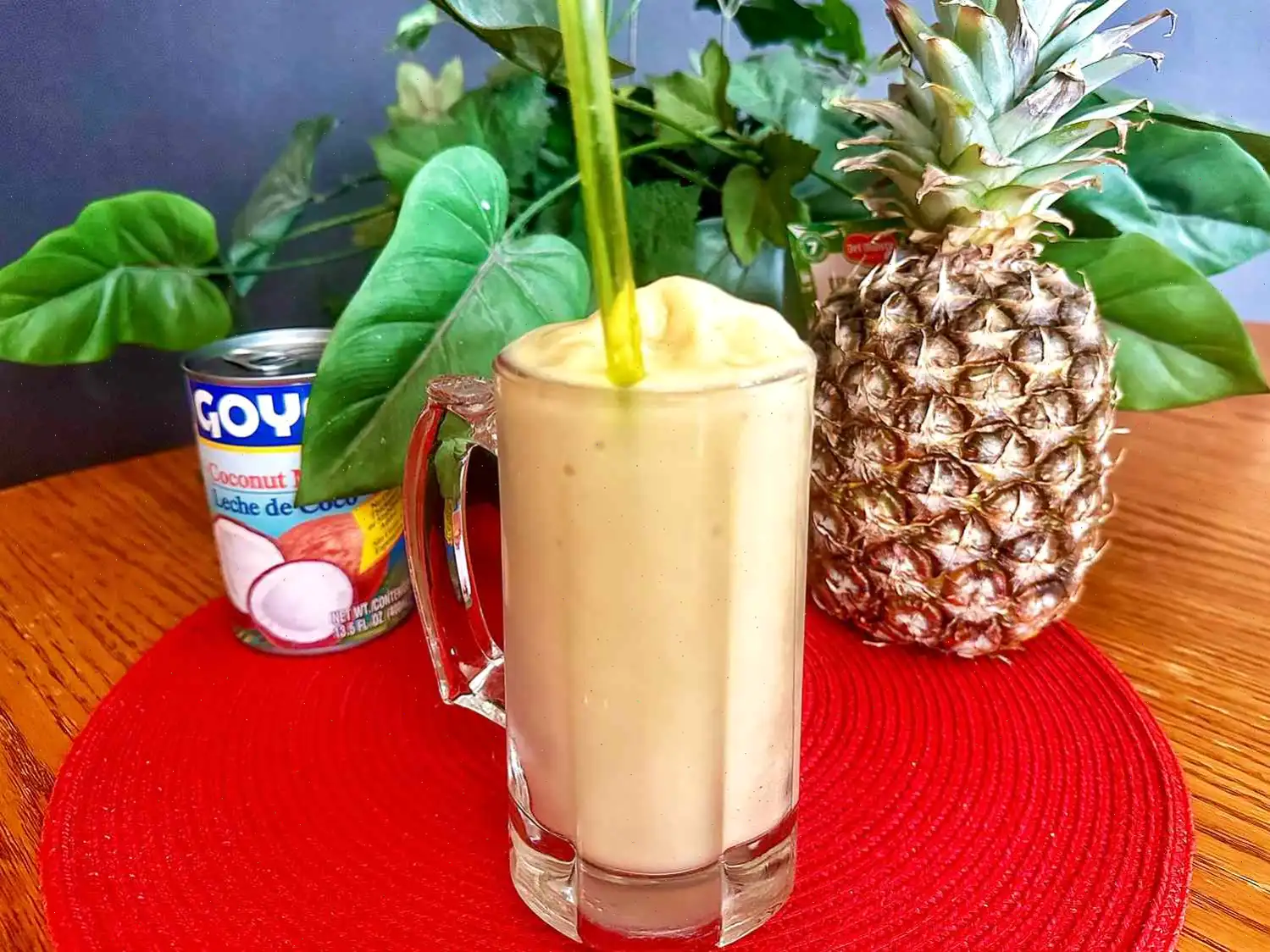
Pineapple Smoothie Recipe
Delicious Tropical Smoothie
Ingredients:
- 1 1/2 cups cubed pineapple, frozen
- 1 banana, sliced and frozen
- 1 cup canned coconut milk
- 1/2 teaspoon coconut extract
- 1/2 teaspoon vanilla extract
Directions:
- Place frozen pineapple, frozen banana, coconut milk, coconut extract, and vanilla extract into a blender.
- Blend everything together until the mixture is smooth and creamy.
- Serve immediately, and enjoy your refreshing tropical smoothie!
Cooks Note: If your smoothie is too thick, simply add more coconut milk to reach your desired consistency.
Nutrition Facts (per serving):
| Nutrition Information | Amount per Serving |
|---|---|
| Calories | 343 |
| Total Fat | 24g |
| Saturated Fat | 21g |
| Cholesterol | 0mg |
| Sodium | 17mg |
| Total Carbohydrate | 33g |
| Dietary Fiber | 3g |
| Total Sugars | 20g |
| Protein | 4g |
| Vitamin C | 65mg |
| Calcium | 40mg |
| Iron | 4mg |
| Potassium | 598mg |
* Percent Daily Values are based on a 2,000 calorie diet. Your daily values may be higher or lower depending on your calorie needs.
** Nutrient information is not available for all ingredients. Amounts are based on available nutrient data.
If you are following a medically restrictive diet, please consult your doctor or registered dietitian before preparing this recipe for personal consumption.

A tropical smoothie made with fresh frozen fruit and canned coconut milk, the pineapple smoothie is a refreshing and nutritious drink that combines the sweet and tangy taste of pineapple with the creamy richness of coconut milk. Its an easy-to-make, vibrant beverage thats perfect for hot summer days, breakfast, or even as a post-workout snack.
History of the Pineapple Smoothie
The pineapple smoothie is a modern creation born out of the growing popularity of smoothies in the late 20th century. While smoothies as we know them today began to gain traction in the 1960s in the United States, the concept of blending fruits with liquid to create a refreshing drink has ancient roots. Cultures around the world have historically combined fruits with liquids such as milk, yogurt, or juices to make nourishing beverages. Pineapple, native to South America, was widely consumed by indigenous people and brought to Europe in the 15th century. However, it was the introduction of blenders and advancements in refrigeration that truly made the pineapple smoothie a global sensation in the last few decades.
Regional Variations and Special Features
While the pineapple smoothie can be found worldwide, it has particular popularity in tropical regions like Southeast Asia, the Caribbean, and Central America, where pineapple is abundantly grown. In these areas, variations of the pineapple smoothie often include locally available ingredients like coconut water, mango, or papaya. Additionally, spices like ginger and turmeric are frequently added to enhance the drink's flavor profile. In Hawaii, pineapple smoothies are sometimes made with added rum for a festive twist, making them a popular choice in beach bars and resorts. In South America, pineapple smoothies are often mixed with passion fruit or a hint of lime, resulting in a tangy and refreshing beverage.
How It Differs from Similar Drinks
What sets the pineapple smoothie apart from other fruit-based smoothies is its unique combination of tropical fruits with coconut milk. Many fruit smoothies use dairy products such as yogurt or milk, but the pineapple smoothie stands out for its dairy-free, coconut-based base, making it suitable for those with lactose intolerance or those following a vegan diet. Unlike smoothies that include large amounts of ice for texture, the frozen fruits in this recipe eliminate the need for ice while preserving the drink's rich, smooth consistency. This helps maintain a naturally sweet flavor and ensures a creamier texture.
Where Its Typically Served
Pineapple smoothies are a popular choice in cafes, juice bars, and smoothie shops worldwide, particularly in warm climates. In countries like the United States, Australia, and Brazil, they are served as a refreshing morning beverage or a post-workout snack. Tropical resorts often serve pineapple smoothies as a welcoming drink for guests, pairing them with other fresh fruit options and light snacks. Street vendors in countries like Thailand and the Philippines often offer fresh, customized smoothies, blending local tropical fruits with coconut water and ice for a quick, refreshing treat. They can also be found in health-conscious restaurants and wellness centers, where they are enjoyed for their natural sugars and nutrient-rich ingredients.
Fun Facts About Pineapple Smoothies
- Pineapple is not only a delicious fruit, but it is also a rich source of vitamin C, which helps boost the immune system and promotes healthy skin.
- Did you know that the pineapple is technically a "multiple fruit," meaning it is formed from the fusion of several small flowers?
- Pineapple smoothies are often used as a base for tropical cocktails, and the combination of pineapple with rum has led to famous drinks like the Pia Colada.
- In some cultures, pineapple is believed to have digestive benefits due to the presence of bromelain, an enzyme that helps break down proteins.
- Frozen fruit, especially pineapple, is used in smoothies because it allows for a thicker, creamier texture without needing to use ice, which can dilute the flavor.
Conclusion
Whether you're making it as a quick snack, enjoying it on a tropical vacation, or sipping it on a hot summer day, the pineapple smoothie is a delicious and nutritious option for anyone looking to enjoy the sweet, tangy flavors of the tropics. Its versatility, refreshing qualities, and health benefits make it a staple drink in many parts of the world. Give it a try and enjoy a taste of the tropics!
FAQ about Pineapple Smoothie Recipe
Comments
Virginia Perez
01/07/2025 06:48:49 PM
Great selection, Don








